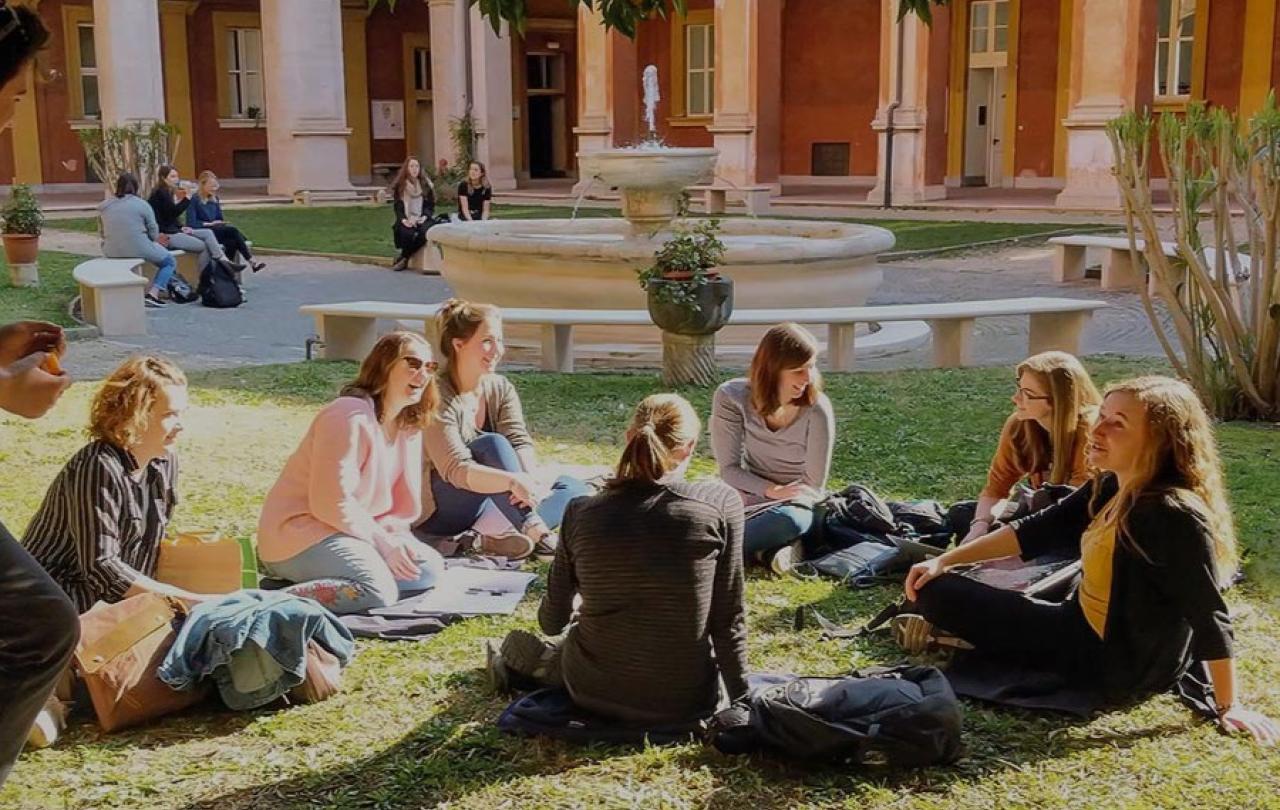
The gardens of the Pontifical University of Saint Thomas Aquinas near to the Vatican are a place of quiet reason, where the mind is trained to seek the fundamental truths of existence. But on a sweltering day approaching summer, the temperature was 31 degrees, and reason had given way to a more immediate need: a glass of water.
It was by the water-cooler, tucked behind a shade-giving tree, that I found him: Lord Rowan Williams of Oystermouth, the former Archbishop of Canterbury, a man whose theological depth is matched only by a palpable, gentle presence. Perhaps it was the heat, or a moment of recklessness, but I asked him for an interview. To my delight, he agreed.
The following day, we met. His recent keynote address, ‘Nicaea, the New Creation, and the Body of Christ,’ had laid the groundwork. What followed was not a simple Q&A, but a deep, meandering conversation—a drawing from the well of a tradition that is both ancient and startlingly immediate.
The grammar of divinity
How do you prepare to speak on a Council with 1,700 years of commentary? For Williams, the entry point is not the what, but the why.
“I started by asking - what was the question Nicaea was trying to answer?” he began. “This is the question Nicaea was trying to resolve: How do we say, at the same time, that Jesus really is the embodiment of the eternalism of God… and that he genuinely opens up for us a new relationship with the Father?”
This is what Williams calls the “deep grammar” of the Council—a phrase he embraces with enthusiasm. The Creed, he suggests, sketches a grammar for divinity itself. It asserts a belief in one God, “but the kind of oneness that God is, is a oneness that's always fertile or productive.”
This productive, self-giving life—kenosis—is not just who God is, but the kind of life we are called to participate in. “God is always reflecting itself in word and spirit… boiling over into creation - that's what God is!... a life that is both self-giving (kenotic) and productive… a life that brings others alive.”
The saints, in their radical openness to this “kenotic presence,” become conduits of this new creation. “Rather mysterious things happen,” Williams notes, “when you allow the act of God to go through you.”
The magnetic quiver
But how do we, in our everyday lives, tune into this deep grammar? Williams points not to the esoteric, but to the ordinary acts of faith that structure our existence.
“We’re called on, first of all, to wake up to the fact that in our ordinary lives we're in fact all the time making acts of faith - the faith that what I say to you and what you say to me can be more or less understood... the faith that human commitment and love are significant and worth investing in.”
This trust, this “connectedness,” is a slow “peeling open of human identity to its depths.” It is a universal experience, a “magnetic needle” in creation that “quivers northwards... quivers Godwards. We can't quite keep it quiet.”
He offers a wry, characteristically British illustration: “one of the great mysteries in British society is that British people are much nicer than the Daily Mail thinks they are!”
This inherent pull, this quiver, is what the doctrines of the Creed are meant to protect and describe. The dense, pub-unfriendly language of “consubstantial with the Father” is not an abstract puzzle but a map of a reality we are already, however faintly, experiencing. “The Holy Spirit draws us into the flow of life,” Williams says. “The Creed keeps us aware of it… it's the shape and form we’re growing into.”
The breath of the Spirit
This brings us to the ancient rift of the filioque clause—the Western addition to the Creed stating the Spirit proceeds from the Father “and the Son.” Is it a fatal block to unity or a matter of semantics?
For Williams, the scriptural reality is paramount. “Jesus says to his disciples I will send you the Holy Spirit who proceeds from the Father. Jesus is saying - you will be receiving a gift from me, which is given me by the Father, to give to you.”
The key, he suggests, is in the tangible action: in John’s Gospel, the resurrected Jesus breathes on his disciples. “Jesus brings the Spirit into action, into full tangible action in human history.” The Spirit proceeds through the Son into the world. At this point, theology reaches its limit. “I’m quite happy to grin feebly and shrug my shoulders...I dunno!” he laughs. “What matters is that the energy of new life and vision is given.”
And this energy, he insists, “goes with the grain of our humanity.” One can almost imagine a divine sigh: “For Heaven’s sake... just wake up to what you are.”
He finds the perfect image in the parable of the Prodigal Son, who, in the depths of his exile, “came to himself.” It is a “paradigm moment” of das Ereignis—a Heideggerian concept for an event of appropriating, of “coming into one’s own.” “There is a self to come to,” Williams affirms, “and a home to go to.”
A unity already given
Will the divided churches ever find structural unity? At times, he admits, we seem to be drifting further apart. But Williams’ focus is on a deeper, prior reality.
“It helps to be aware that there's a unity given already. We're not quite sure how to embody it. We're not quite sure how to organise it. But there's something there.”
Finally, reflecting on the Council itself, he dismisses any notion of Nicaea as a merely political project for a fractious empire, though Constantine’s desire for harmony was a factor. He paints a visceral picture of the attending bishops, as described by Eusebius: men with missing hands, gouged eyes, and the scars of persecution. When Constantine greeted them, “he kneels down and kisses their wounds.”
“They're not just purple cassocked prelates sitting in armchairs! Their faith has been through the fire!”
This is the well from which this Creed was drawn. It is a creed of the persecuted, a truth forged in fire. A truth, as Williams learned from Pakistani Christians this year who heard the story of Nicaea and simply said, “we know about that,” that is known in the bones before it is understood in the mind. It is the water that waits, cool and deep, for any who come thirsty.
Support Seen & Unseen
Since Spring 2023, our readers have enjoyed over 1,500 articles. All for free.
This is made possible through the generosity of our amazing community of supporters.
If you enjoy Seen & Unseen, would you consider making a gift towards our work?
Do so by joining Behind The Seen. Alongside other benefits, you’ll receive an extra fortnightly email from me sharing my reading and reflections on the ideas that are shaping our times.
Graham Tomlin
Editor-in-Chief





